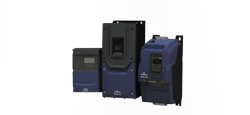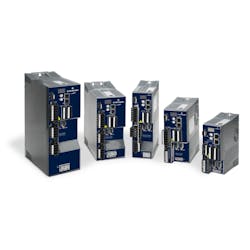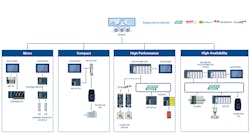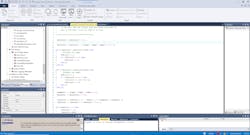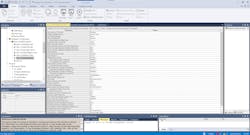Simplifying motor and motion control architectures
Electric motors are an essential technology as the prime movers for many types of OEM processing machinery and other manufacturing equipment. However, modern equipment usually calls upon motors to do much more than simply drive a load. Advanced control is necessary to achieve energy efficiency, along with optimized process and equipment functionality, while digital communications are needed to support IIoT initiatives and enhanced diagnostics.
Designers are familiar with implementing variable frequency drives (VFDs) used to control AC motors for pump, fan, conveyor and other applications. For more precise motor control, especially with robotics and other finely controlled processing equipment, servo motors and drives are usually selected, although they are generally more expensive and can be complex to implement due to the load physics and required intricate motion profiles. But to a large extent, these two types of motor control domains have been relatively independent, requiring designers to learn multiple products and toolsets, and sometimes develop ways to seamlessly combine the two types of motion control.
In most cases, automation is implemented by programmable logic controllers (PLCs), process automation controllers (PACs) or edge controllers which need to communicate with, monitor and issue commands to motor controllers. As manufacturing machinery is becoming more sophisticated and highly integrated, and as design teams are tasked with adding greater data connectivity, there is an increasing need for motor and motion technologies offering a more consistent automation development experience, along with provisions for streamlined networking.
Increased integration
Many OEMs and manufacturers develop and employ equipment using a combination of VFDs and servos (Figure 1). For example, a VFD-driven conveyor may feed product to a servo-operated pick-and-place system, while a filling or packaging machine may use VFDs for the main drives, but servos for detailed operations like capping and labeling.
In the past, it has often been adequate for designers to specify and configure each type of drive system independently. However, this meant they needed to learn and become proficient with at least two different platforms. Furthermore, when the operation of VFDs and servos needed to be coordinated, designers would need to develop custom code, and then identify variables and parameters to communicate among the two types of drives.
As control efforts are becoming more sophisticated, and as the need for data connectivity is accelerating to support analytical and IIoT initiatives, developers are looking for better and simpler motor and motion control solutions.
Coordinating hardware and software
Consolidating the capabilities of VFD-driven motors and servo motors requires careful coordination between the drive hardware and associated controller software and communication elements. There is some overlap in capabilities between these motor types, but normally there is a clear distinction for when each is used. In addition, servos have much more complex command and control capabilities than standard VFD-driven motors.
Certainly, there are industry standards for industrial communications protocols, and for a degree of open PLC programming. But each motor control vendor incorporates functionality and data structures in various ways, making it more difficult to reconcile and correlate these devices from an automation standpoint.
The most comprehensive way for users to integrate various motor types in their applications is to use hardware drive and controller products offered by a single vendor (Figure 2). This is because the drive configuration and the associated PLC/PAC/edge controller development environment can be closely coupled, with software blocks and configurations organized for consistency.
A single hardware and software platform simplifies integrations with a common architecture and programming methodology. One platform provides easy access to data across the entire machine or automated system, enabling new insights that were never possible before.
One development environment to rule them all
While any combination of VFDs, servo controllers and automation controllers can be interconnected and made to work together, the degree of effort involved typically increases as more and different makes and models are involved. Multi-platform integration is possible, but it is more complex initially than using an integrated environment, and it introduces additional challenges for ongoing support.
A single development environment — also known as a toolset — means that users only have one initial learning curve, and they can then apply their expertise across a wide range of motor and motion products. This common toolset is engineered to support transporting data and variables from drives on the factory floor, through intermediate automation controllers and all the way up to the cloud if desired (Figure 3).
Equally important for users is the availability of programming blocks for the most typical control and monitoring functions, and readily accessed configuration displays for motor control devices (Figure 4). VFDs and servo drives can accept data basic downloads commanding them to run, stop and move at various speeds. However, the availability of predefined programming blocks simplifies coding and applications — especially for motion movements where servos are commanded to positions and velocities over a potentially complex acceleration profile.
In fact, some of the most intricate motion capabilities — such as synchronization of dozens of axes, on-the-fly camming profile changes and 64-bit floating point precision — are best implemented using function blocks, instead of struggling with custom coding.
Programming blocks make it clear and easy for PLC developers to access and interact with drive parameters, and they provide built-in standardization. Diagnostics are readily available at the PLC and human-machine interface (HMI) level, making commissioning and subsequent support easier.
Motion in the field
One equipment OEM had been used to the familiar approach of using one vendor for the PLC/HMI automation, and separate vendors for VFD motor control. Every time they commissioned a system, they reserved two to four days for configuring VFDs, tuning them to the connected motors, establishing network connections with the PLC and verifying that all commands and data mapping worked properly.
By moving to automation controllers and VFDs from a coordinated product family, and by performing the software work in a single development environment, they streamlined startup efforts significantly. VFD commissioning with the PLC/HMI was reduced to just a few hours, and users had greater confidence and clarity in the resulting software configuration. Once the entire system was in production, the engineering and maintenance personnel could support operations using the single common software platform.
Making the move
Electric motors and servo motors are capable of advanced functionality, but users need to integrate them smoothly with PLC/PAC/edge controllers and HMIs. To take full advantage of performance and energy savings benefits, developers need ready access to drive functions and data. Traditional methods called for users to develop their own interfaces among various makes and models of products. However, the availability of a coordinated portfolio of drive, controller and software products is making this task easier for users.
As users are pursuing ways to develop data driven IIoT solutions, the task is simplified when a single platform can concentrate all the data, so that digesting it and processing it into actionable information is streamlined. Developers prefer working in a single and thoroughly harmonized configuration environment, with access to consistent function blocks and data structures. This results in reduced development time, simplified architectures, minimized total overall cost, faster commissioning and easier support throughout the products’ lifecycle.
Dan Smith is the senior product manager of motion & safety products, for the Emerson Controls & Software business. Dan is responsible for developing new motion and safety products that simplify integration and maintenance for customers. Dan holds a bachelor’s degree in Engineering Science from Penn State and is based in West Chester, Pennsylvania.
Emerson
About the Author
Daniel Smith
Senior product manager of motion & safety products, for the Emerson Controls & Software business
Dan Smith is the senior product manager of motion & safety products, for the Emerson Controls & Software business. Dan is responsible for developing new motion and safety products that simplify integration and maintenance for customers. Dan holds a bachelor’s degree in Engineering Science from Penn State and is based in West Chester, Pennsylvania.
